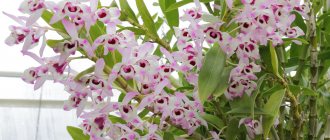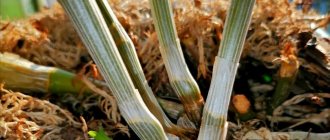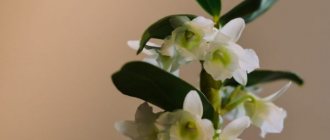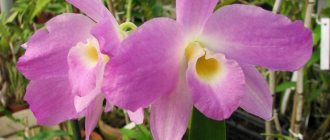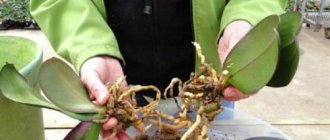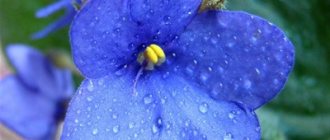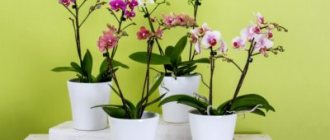Care after flowering...
There are three phases in the life cycle of Dendrobium nobile: flowering, growth and dormancy.
In the first phase, which most often occurs in spring, flowers bloom. Their number reaches 20 pieces. Sooner or later, flowering ends: the flowers wither and fall off. Then the question arises, what to do next?
Leave the orchid in a cool place and wait for new growth to appear. Stop intensively moistening the plant. The new growth must take root of its own. When their size reaches several centimeters, watering can be resumed. The soil should dry out well between waterings. When the new growths are strong enough and begin to inflate, it is recommended to stop watering for a while and lower the temperature.
Keep without watering for a week. This stimulates the formation of flower buds. As soon as the buds appear, start watering again, otherwise it will grow babies rather than flowers.
Completely dried flower stalks are cut off after flowering. Green ones are left or trimmed.
The pseudobulb should not be removed unnecessarily after flowering. Only if it dries completely, when it gives up the accumulated nutrients and water. If the pseudobulb has green buds that have not yet bloomed, the orchid may produce new flowers. By properly caring for Dendrobium nobile, you can achieve re-blooming.
Third stage: the leaves turn yellow, fall off, and preparations are underway for the dormant period. Watering is reduced, and the introduction of additional nutrition is completely eliminated.
The dormant period falls at the end of autumn - beginning of winter.
From the end of October, Dendrobium begins a dormant period, which lasts about 2 months. It is not as pronounced as in its natural environment, but the plant will need rest. At the same time, stop watering. The introduction of additional nutrition is completely excluded. Temperature during the day +15-18℃, at night +8-10°C. The plant is placed in the brightest, driest place.
If daily temperature fluctuations cannot be created, then the plant is placed at a constant temperature of about 10-12°C.
The appearance of young shoots at the base of the bulb means the end of the dormant period; watering is resumed. The plant is fed with increased concentrations of potassium and phosphorus, which are necessary for the formation of flower buds.
Typically, dendrobium flowering lasts 8-12 weeks; at high ambient temperatures it may be shortened. Lack of flowers: insufficient lighting, no rest period provided.
Sources
- https://komnatnie.com/orhid/phal/sortaf/dendrobium.html
- https://stroy-podskazka.ru/dendrobium/falenopsis-opisanie/
- https://gileya.kherson.ua/ru/enciklopediya/orhideja/dendrobium
- https://ogorod-bez-hlopot.ru/dendrobium-falenopsis-sorta-uxod.html
- https://sadov0d.ru/komnatnyie-rasteniya/orchideya-dendrobium-falenopsis.html
- https://domfloris.ru/orhidei/orhideya-dendrobium-foto-i-nazvaniya-s-opisaniem-vidov.html
Breeding tree orchids by children: photo
Dendrobium shares with gardeners side shoots, which are also called “babies”. They grow in the lateral axils and then develop into small plants with their own root system and leaves.
In order for an orchid to produce “babies,” you need to create stressful conditions for it. This is done in winter, during the dormant period. Move the orchid to a cool place and reduce watering to a minimum. After the flower buds appear, the flower is returned to its usual conditions. Among the buds that appear after stimulation, there will be those that will produce “babies.”
Interesting! Some gardeners plant several children at the same time in a common pot. The goal is to make the first flowering more spectacular. Then the plants are divided into separate pots.
How to separate children
Children are separated only when the young offspring:
- its own root system has formed (at least 4-5 roots);
- more than 4 leaves have grown;
- the roots are about 5 cm long.
Children are separated like this:
- disinfect scissors or blade;
- make a cut under the base of the baby;
- Treat the mother plant with crushed coal.
Boarding procedure
An older child should be placed in a small pot. It requires the same substrate as an adult plant. Necessary:
- prepare a container for the baby;
- put drainage on the bottom;
- place the baby in the prepared pot;
- cover the roots with substrate.
Important! Dendrobium babies are not placed in water. Moisture will destroy them.
How to properly care
In order for a culture to develop normally, it should be provided with complete and high-quality care.
Temperature
In summer, the optimal daytime temperature is considered to be +20-25 degrees. At night the indicator should be +16-21 degrees. In winter, it is not recommended to exceed the daily mark of +20 degrees. At night the maximum temperature should be +18 degrees. This mode is optimal for heat-loving orchid species.
Illumination
Light requirements depend on the type of orchid. Moreover, all varieties love bright, diffused light. The flower needs protection from direct sunlight. It is worth considering that all types react negatively to the effects of drafts.
Watering mode
In spring and summer, orchids require abundant watering. It is recommended to avoid stagnation of liquid in the substrate. This will cause root rot. For irrigation, you should use settled or filtered water.
Air humidity
The culture requires high air humidity, which should be 50-80%. In summer, it is recommended to keep the plant outside and spray its leaves as often as possible. In winter, the container with the culture should be placed on a tray, which is recommended to be filled with wet gravel.
Transfer
Dendrobium does not tolerate transplantation. Therefore, this procedure should be performed as rarely as possible – once every 3-4 years. Species that bloom in spring should be replanted immediately after this process is completed. Plants that produce flowers in the fall are moved to a new location when young shoots begin to develop.
A pot that is not too large is suitable for the plant. It can be made from any material. It is worth placing several heavy stones at the bottom. Place a drainage layer on top. To do this, it is recommended to use expanded clay or polystyrene foam.
Then you should pour coarse bark and carefully transfer the flower into a new pot. The voids are filled with new substrate
To plant the plant, you should use ready-made soil for orchids.
Fertilizer and feeding
It is recommended to apply fertilizers exclusively during the period of active growth - from April to September. This procedure is performed every 15 days. To do this, you can use liquid fertilizer for orchids. All types of heat-loving dendrobiums require the systematic use of fertilizers based on potassium and phosphorus. This composition is applied once a month. It is recommended to feed cool-season orchids with nitrogen 2-3 times a month.
During flowering
Orchids bloom at different times. The duration of this process is 2-3 months. To achieve a timely start to flowering, a difference between night and day temperatures of 5-7 degrees is required. This is easiest to achieve in the summer.
After flowering
When flowering ends, watering should be gradually reduced. In this case, the peduncle is cut off and the crop is moved to a cool place. In this case, the culture will be able to fully relax and gain strength. In winter, the bush requires mandatory additional lighting. For this, it is definitely recommended to use a phytolamp.
Requirements for pot and soil
Dendrobium requires a spacious pot. It should be quite wide. The roots of the plant do not participate in photosynthesis, so it does not require a transparent container. Some epiphytes with cascading flowers are recommended to be planted in hanging baskets.
For the plant, you should use a standard substrate, which includes a mixture of sphagnum, peat, pine bark, and charcoal. Before planting, a drainage layer is placed on the bottom of the container, which will help avoid stagnation of moisture.
Detailed instructions on how to transplant an orchid at home, photo
Next, we will describe transplanting dendrobium at home with photos, step by step. This will allow you to avoid various mistakes in the process.
How to remove from pot
If the container is plastic, then first apply a little pressure on its walls from all sides. As a result, the soil will be slightly compacted and the lump will come out easier. If this does not happen, then carefully cut the container lengthwise.
Place the terracotta pot in a bowl of water - usually after this the flower comes out almost freely. Otherwise, carefully break it by hitting it with a hammer at the very bottom.
Cleaning the roots
If the underground part of the flower is highly developed, then it can be quite difficult to rid it of the substrate. However, in order to safely transplant the dendrobium, you will have to do this.
Soaking the orchid in a bowl of warm (about +30°C) water will help reduce the amount of damage. Leave it in the bath for 20 minutes.
Afterwards, it will not be difficult to untangle the rhizomes and remove the remaining substrate. Do not remove the dendrobium from the basin. To prevent dirty water from disturbing you, place a container under an open tap.
When all the particles of soil are gone, rinse the flower in the shower. Do not try to extract tightly stuck pieces of bark - this is not important.
Root inspection and pruning
During the transplant process, you have an ideal opportunity to examine the lower part of the orchid, so do not neglect it.
Examine the roots under bright light. Cut off all damaged shoots, as well as those that are simply suspicious, with scissors. Don't forget to sterilize the instrument with alcohol.
The remaining wounds should be rubbed with crushed activated carbon. After this, the dendrobium is left to dry.
It is not difficult to identify healthy roots. They:
- hard;
- elastic;
- silvery or greenish;
- without voids, holes and multi-colored spots.
Drying
After washing, the orchid must be left in a warm but ventilated room for at least 2 hours. Nothing bad will happen to it, because dendrobiums are epiphytes, that is, they do not need soil.
It is optimal to extend drying throughout the night, then in the morning you can calmly complete the remaining steps.
Planting an adult dendrobium and children
Place a layer of drainage about 2-3 cm thick in a selected pot. Place some relatively large pieces of clean bark on it.
After this, place the orchid clearly in the center. To prevent it from falling over on its side, spread it with thin slats, placing them in a hut and tying them up. Remove supports after rooting. Next, fill the free space with substrate. Make sure that the pseudobulbs remain on the surface.
The baby is taken from the dendrobium only when it enters the dormant stage. Since the transplant is carried out immediately after it, it is quite possible to carry out these procedures simultaneously.
Carefully separate the young shoots from the mother with a sterile knife. Powder the wound with grated activated carbon and dry.
Tip: before planting the resulting baby, soak it in a growth stimulator (follow the product manufacturer’s recommendations).
For the shoots, prepare small pots (for example, transparent disposable cups). Be sure to make several large drainage holes in them.
Use a standard commercial or homemade substrate for orchids.
Then proceed as follows:
- Place a piece of sphagnum moss on the bottom;
- install the baby on it;
- keeping it in an upright position, add soil (strictly to the root collar).
Watering
It doesn’t matter whether the soil is dry or wet, you should not give water in both cases. Wait at least 2 days, only then water the flower sparingly.
In the future, carry out irrigation at the usual intensity, but slightly reduce the volume of moisture in the first 2 weeks. Try not to get it on the leaves or stem.
The water must be boiled and cooled to a temperature of +25°C...+30°C. Colder temperatures can cause root rot.
Houseplant care
- Lighting. Orchid loves bright light.
- Temperature. It is necessary to observe the temperature regime for rapid flower growth.
- Watering. You can’t overwater the plant, but you also can’t let it dry out.
- Fertilizer feeding. For full development and to protect the orchid from diseases.
- Maintain indoor air humidity. If the air in the room is dry, the plant will dry out.
To learn how to properly care for your Dendrobium orchid, you need to consider each of the above points. Let's get acquainted with them in more detail.
Lighting
This is the most important moment of caring for a flower at home. Any variety of orchid, including Dendrobium, is very photophilous and needs a lot of bright light. Since this is necessary for its flowering, especially for varieties with bright colors. Daylight hours should last at least 12 hours.
In the autumn-winter period, as a rule, additional lighting sources are used - lamps. If there is insufficient lighting, Dendrobium will not be able to please you with its bright, beautiful blooms.
Reference. The Dendrobium orchid, unlike other species, does not need to be turned to the light in different directions.
Temperature
Moderate temperature for active growth of this type of orchid is from 17 to 25 degrees. At night, the optimal temperature is no higher than 21 degrees. Types of cool keeping in the spring-summer period require a temperature of 15 to 18 degrees during the day, and about 12 degrees at night.
In autumn and winter, the orchid needs a room temperature of 12 to 16 degrees.
Therefore, frostbite of the flower should be avoided to avoid unwanted effects.
How to water and feed correctly?
Watering and fertilizing for this type of orchid is no less important than other types of care. Dendrobium needs to be watered in different quantities at different times of the year. In spring and summer, the plant in the pot should be moistened abundantly. And autumn and winter is a dormant period for orchids, so watering should be more sparse. The main thing is that watering is carried out with settled or boiled water at room temperature.
But as for feeding, it also needs to be done at a certain time. It is advisable to produce it from April to September using complex mineral fertilizers. As a rule, fertilize the substrate once every 10–15 days.
Important! It is necessary to purchase fertilizers that are suitable specifically for this type of orchid.
The video below describes the rules for watering dendrobium:
Air humidity
The optimal air humidity for this plant should be from 50 to 70%. Therefore, during the winter heating season, the bush should be sprayed with warm water as often as possible. Since it is in winter that the air in the room is dry, and this can have a detrimental effect on the plant. During this period of time, it is best to place the flower pot on a tray filled with damp crushed stone.
It is necessary to spray the above-ground part 1-3 times a week, depending on the air humidity in the room.
Further care
It is recommended to protect the transplanted orchid from bright light. Therefore, place the pot with it behind a light curtain and make sure that the sun’s rays do not fall on it.
The optimal temperature during the rehabilitation period should be between +20°C and +22°C. Give water more often, but in minimal portions - do not allow the substrate to become waterlogged.
Start fertilizing only when the flower gets stronger and enters the growing season.
Suitable air humidity is 60-70%.
How to care for children
Place the container with young dendrobium in a wide plate. If the room is hot, pour water over the edge of the pot onto the substrate. If the humidity is high, simply add a little liquid to the tray. Protect your baby from drafts.
The formation of a new leaf will indicate that the seedling has taken root. When this happens, start applying complex fertilizers, diluting them twice as much as recommended. Frequency: 2 times a month. At first, spray the above-ground part of the flower with the prepared solution. After about a month, use nutrient preparations during watering.
Dendrobium is extremely sensitive to transplantation, but if everything is done correctly, it will quickly recover and begin to grow. Proper care of your orchid will allow you to enjoy its company for many years. Let our advice help you with this.
How to properly care?
A distinctive feature of dendrobium is that it has a dormant period. After it finishes flowering it appears to stop growing, this is not the case, in fact it goes into a dormant period. In this case, watering is reduced to a minimum. It is also better to keep the temperature quite low, around 17-21 degrees. After dormancy ends, the plant begins to grow new shoots.
Dendrobium blooms as continuous bushes when neither pseudobulbs nor leaves are visible. It may seem like they are just balls of flowers. An interesting feature of this plant is the presence of so-called children. If the dendrorium blooms at the wrong time and the babies grow on the pseudobulb, this is a sign that the care is not being carried out correctly.
Sometimes the dendrobium can take root above the surface of the ground, in which case nothing needs to be done. If you sprinkle soil on top, the plant may stop growing.
An easy way to transplant
The peculiarity of the denrobium orchid is that its root system grows quite quickly. At times, you need to move your indoor flower into a larger pot more often than other orchid varieties. If the flower is healthy, the roots are not damaged, and the substrate is still good, then “transshipment” is most often used:
- Soak the soil mixture and disassemble it into smaller parts.
- Clean the roots from damaged dead shoots.
- Gently loosen the old soil and renew it by adding some fresh substrate.
- For disinfection purposes, place small pieces of charcoal into the soil mixture.
This method allows you to partially preserve the usual habitat when transplanting dendrobium. Adaptation with this method will not be so painful. In fact, the houseplant is simply moved into a larger pot. Flower growers advise combining such a transplant with orchid propagation.
Secrets of growing dendrobium orchids
There are techniques and methods that allow you to optimize the process of growing dendrobium in your home. Knowing the subtleties of these types of flowers, you can achieve high levels of aesthetics, provide the conditions the plant needs, and ensure abundant and long-lasting flowering.
One of the watering options is to place the pot in water
How to properly water dendrobium
Orchids are quite moisture-loving. You can water either in the classical way - pouring moisture into the pot, or submersibly - occasionally placing the root of the plant in a container of water. This is especially convenient for growing in baskets or blocks. The signal for the next watering is the dry top layer of soil. In winter, watering is significantly reduced, only occasionally moistening the substrate in small portions. In summer, fertilizers are added to the water. Be careful: do not allow water to get on the upper parts of the plant so that it does not rot. The water should always be slightly lukewarm and soft in composition. If there is no filter, boil water for irrigation.
Feeding during the growing season
Feeding the dendrobium orchid is necessary during the period of active growth. This is the period from the end of flowering until the onset of dormancy. In Russia, it chronologically coincides with the warm season - the end of spring, summer and beginning of autumn. It is at this time that the dendrobium actively grows with green mass. He needs help in this matter by adding nutrients.
Liquid fertilizers for orchids
A special group of fertilizers for orchids is intended for application to leaves by spraying. It can be found in stores under the name Orchid Leaf Care. Most of these formulations contain urea.
The other group is intended for absorption by the root system and assimilation by the plant “naturally”. They are sold in liquid form and have common names like Fytopan, Orchid Food and others.
To feed, mix the liquid in a 1:1 ratio with water, pour it into the pot at the end of watering so as not to burn the rhizomes. The frequency of fertilization is every 3-4 waterings.
How to get dendrobium to bloom
If you want to make your orchid bloom, then you need to follow several important rules:
- provide a sufficient level of illumination;
- along with the light, the orchid must receive a sufficient flow of air, that is, stand in the summer and autumn either in a draft or in the open air;
- do not overfeed or over-water the dendrobium;
- After the end of the active growing season, place future buds in the cold, down to 12 degrees.
In appropriate conditions, denbrobium will delight you with flowering
Dendrobium has a characteristic feature: this orchid will transform buds into babies without decreasing the temperature, that is, continue to grow with green mass. Thus, a decrease in temperature, especially at night, is key to initiating the flowering process.
How to water
It is recommended to water all types of orchids in the morning so that the leaves dry before dark. The frequency of watering depends on the following factors:
- substrate used;
- type of pot (plastic or clay);
- container size.
Dendrobiums do not like cramped pots; moisture in them takes longer to evaporate and should be watered once every 10-14 days so that the roots have time to dry. When watering, place the orchid in the sink and run cool tap water over it. Do not use distilled or softened water.
After watering, you should leave the container so that the moisture drains from the roots of the plant for 5-10 minutes. Then a preventive examination of the dendrobium is carried out. Regular checks will allow you to notice signs of pests or flower disease in time.
Dendrobium orchid types and photographs
Currently, approximately 1,200 species of dendrobium are known. Natural species go on general sale much less often than hybrids created on their basis. They can be purchased at nurseries and botanical gardens, where they are used to breed new species. The following species are best suited for growing at home: Dendrobium nobilis, Dendrobium moniliforme, Dendrobium densely flowered, Dendrobium King, Dendrobium Parisha, Dendrobium phalaenopsis.
Dendrobium noble
Dendrobium nobile is one of the most popular and widespread species in cultivation; it has more than 80 varieties. The name of the species is derived from the word “nobile”, which means “famous, noble, noticeable”.
The Dendrobium nobilis orchid is a large epiphytic plant up to 90 cm high. Its stems are large, fleshy, swollen. The leaves are located on both sides of the stem and have an oblong elliptical shape. Short peduncles develop 3-4 flowers with a diameter of up to 10 cm. The flowers vary in color from white to dark purple. The lip is white with a large dark purple spot. It most often blooms from January to May.
Dendrobium moniliforme
Pictured is Dendrobium moniliforme
Dendrobium moniliforme is a Japanese endemic orchid that resembles Dendrobium nobilis, but is much smaller in size. The size of an adult plant is about 15 cm, and it begins to bloom when it reaches only 5–6 cm. The flowers are pink-white, fragrant. Blooms from late winter to early autumn.
Dendrobium dense-flowered
Dendrobium densiflorum is an epiphytic erect orchid. The tetrahedral stems thicken and have quite pronounced nodes, on top of which 3–4 leaves grow. The leaves are narrow, elliptical or lanceolate, rather fleshy and smooth. Dense inflorescences are collected in sagging racemes, which consist of a large number of flowers (from 50 to 100 pieces). The lip is pubescent, yellow-orange. The flowers are yellow-orange, their diameter is no more than 5 cm.
Dendrobium King
Dendrobium kingianum is a small epiphytic orchid. It has rigid cylindrical stems that thicken at the top. The leaves are located on the upper part of the stem in 3-4 pieces, lanceolate, up to 30 cm long and 3 cm wide. The flowers are small, collected in a raceme, and have a color from white to bright purple. The flowers are very fragrant, up to 2 cm in size. A special feature of this species is the curled tubular base of the lip around the column. Flowering begins in February and lasts for two weeks.
Dendrobium Parisha
Pictured is Dendrobium Parisha
Dendrobium parishii is an epiphytic deciduous orchid, reminiscent of Dendrobium nobilis. Its stems are thick, hanging, up to 40 cm long. The leaves are oblong, lanceolate, and have a small cut at the end. Inflorescences are few-flowered. The diameter of the flowers is up to 10 cm, color from pink to lilac. The lip of the flower is diamond-shaped or round, pink or white, decorated at the base with two dark purple spots. Blooms in spring or summer.
Dendrobium phalaenopsis
Dendrobium phalaenopsis is a large semi-deciduous orchid. The stems are long, erect, fleshy. They thicken towards the top and are up to 60 cm long. The leaves are lanceolate, long, and grow in the upper part of the stems. The peduncle reaches 60 cm in length. Large flowers, which are up to 9 cm in diameter, are colored in lilac-violet shades. It blooms from November to January, the flowering period is 5–6 weeks. At the moment, a large number of subspecies of Dendrobium phalaenopsis have been bred, which differ in the period and duration of flowering, as well as the color of the inflorescences.
Reproduction
Dendrobium nobile is a plant that can be propagated easily and in a variety of ways. Of these, flower growers practice three main ones: with children, cuttings and dividing the bush.
kids
The simplest and most reliable way. Children are lateral processes, sometimes formed from pseudobulbs. To get a new plant, just wait until the roots of one of them reach 5 cm in length. After this, the baby can be separated and planted in a separate pot.
Cuttings
To prepare cuttings you will need an old pseudobulb - the one that has shed its leaves. It is cut and divided into cuttings so that each has two or three “dormant” buds.
The finished cuttings are placed in a container with damp moss, covered with film or glass and placed in a bright and warm place (about +22 °C) for several weeks. From time to time, the moss needs to be moistened and the greenhouse needs to be ventilated. Seedlings are ready to be transplanted into separate pots when their roots grow to 5 cm.
Dividing the bush
A mature bush with several stems will do. The point is to separate one of them and plant it in another pot.
You should make sure that the selected shoot has both old bulbs and new shoots, and that the roots are of sufficient length.
The fracture sites must be treated with activated carbon. Further care does not differ from that required by an adult plant.
What conditions are necessary for the plant?
Due to the fact that the dendrobium is considered a representative of the epiphyte family, it is worth understanding that good care at home consists of providing moist air, sufficient lighting and an optimal amount of moisture.
Tips for choosing
Pot
You should choose a ceramic or plastic pot for an orchid, preferably not transparent. This plant needs drainage. Therefore, it is imperative to place a drainage layer at the bottom of the pot.
What kind of soil is needed?
What kind of soil is needed for the plant? Gardeners advise using special soil for dendrobiums, intended for epiphytic orchids. A good option for growing orchids is to prepare the soil mixture yourself. You need to mix peat soil, sphagnum, pine bark and charcoal. Peat is necessary to provide the recommended acidic environment.
When preparing the soil yourself, it is advisable to boil the future substrate for 10 minutes and then dry it. It is worth doing this in order to disinfect the soil, this way you can avoid infecting the plant with pests and bacteria.
A drainage consisting of crushed stone or broken brick is placed at the bottom of the pot. Gardeners recommend placing large pieces of tree bark on top of the drainage. Then crushed pieces of bark are placed.
We recommend watching a video about preparing a substrate for dendrobium:
Location
Dendrobium needs sunbathing, therefore, to ensure favorable conditions for the existence of the flower, it must be placed on windows facing south. If the plant is located on the east or west sides, it will be necessary to install additional artificial lighting. North-facing windows are not at all suitable for providing comfortable conditions for dendrobium.
Lighting
Dendrobium is a light-loving plant. It is necessary to provide it with bright light, but not direct sunlight.
Important: The plant should not be placed in bright sunlight right away; it must be gradually trained. If the plant is located in direct sunlight, it needs to provide air movement.
How often to water and shower?
During the growing season, the plant needs a lot of water. It is recommended to water without waiting for the substrate to dry out. If it is a hot day, watering should be done every day. If the weather is cloudy or rainy, you need to water when the substrate begins to dry out, about 2 times a week. If there is water left in the pan, it must be drained 15 minutes after watering. This time is enough for the flower to be saturated with water. Otherwise, the roots may simply rot.
The best time for watering is considered to be morning. With the onset of frost, you should stop watering the flower. Then you need to rinse the roots in the pot with clean running water to wash away all the remaining salt and extra fertilizer. The roots should remain clean during the dormant period. Watering stops until the flower buds wake up.
Dendrobium prefers to be in a room with high humidity. To ensure favorable conditions for the orchid, it is recommended to spray it every day.
Watering must be done with water at room temperature, preferably settled.
We recommend watching a video about proper watering of dendrobium orchids:
Temperature
Dendrobium is a plant resistant to any temperature. Can withstand even negative temperatures. In hot weather, it can be in conditions with temperatures up to 38 degrees. Of course, do not forget about air ventilation.
Orchids are extremely sensitive to large and sudden fluctuations in temperature, as well as cold!
Fertilizer
It is necessary to feed denrobium starting in spring. It is recommended to use a complex fertilizer containing nitrogen, phosphorus, and potassium in equal proportions. Fertilizer frequency: 1 time per week. To get gorgeous blooms, the fertilizer solution should be in the ratio: 1 teaspoon per 4-liter bucket.
It is necessary to shed fertilizer after watering the plant, then the roots will already be saturated with moisture, which will prevent them from being burned. Starting in August, the fertilizer must be of a different type. From now on, there should be no nitrogen in the fertilizers. Otherwise, babies will grow on pseudobulbs. This way you can get lush blooms at the end of winter.
Care
With proper and competent care for dendrobium phalaenopsis at home, the plant will delight you with its beautiful appearance for up to 8 years. Of all the varieties of orchids, dendrobium phalaenopsis is the most unpretentious and hardy, so it is perfect as a pet for beginners who have no experience in growing this type of plant.
The main feature of the flower is the ability to adapt to any climatic conditions. The plant loves light, but does not tolerate direct sunlight, so the ideal place for it would be on a windowsill facing southeast. If the dendrobium phalaenopsis is located on the windows of a southern landmark, then from the second half of March you need to make sure that the bright sun does not harm the young shoots and be sure to shade it with a light curtain at noon. Aluminum blinds can be used, but you need to be careful; misdirected slats can also reflect the flow of light and cause thermal burns to both bulbs and leaves. In winter, it is recommended to use additional lighting to stimulate plant growth.
Dendrobium should be sufficiently lit. The color of the leaves will tell you whether the plant has enough light: bright light green indicates an excess of light; dark green ones “report” that the flower is lacking light; yellow ones appear in very poor lighting; an even green tint indicates that the plant is receiving enough light.
Air temperature is not particularly important for this plant. It can feel great both at +10°C and at +42°C, since in its natural environment it has to adapt to different temperature conditions. During the period of active growth, it is advisable to maintain the daytime temperature around 20-26°C, and at night - 15-20°C. At this time, the orchid will benefit from being outdoors - on an unglazed balcony, veranda or in the garden. The natural daily temperature difference is necessary for active development, the formation of flower buds and lush flowering in winter. The second feature is that for winter flowering, dendrobium requires a period of rest from the beginning of November to the end of December.
An important condition for good growth of phalaenopsis dendrobium is an average level of air humidity. Dendrobium comes from tropical forests with high humidity, reaching 55-60%. Therefore, it is advisable to create conditions for him that are close to natural. The plant loves to be sprayed with a spray bottle. It must be carried out daily, using soft, settled water with a minimum content of chlorine. Spraying can be carried out both to increase air humidity and clean leaves from dust, and for the purpose of surface feeding. Only the upper part of the leaves should be sprayed with water to avoid disruption of gas exchange.
To maintain the required level of humidity, you can place moss in the orchid pot or place a container of water next to the pot. Humidity is maintained around the plant, but not in the room itself. An environment that is too damp promotes the growth of bacteria as well as fungi. Under such conditions, the orchid will be at risk of infection.
Watering the plant should be done as the soil dries. In summer and spring, it is recommended to moisten the soil more often than in winter and autumn, since the frequency of watering directly depends on the temperature and dryness of the air. The higher these parameters, the more abundantly and more often watering is required. Take warm water at a temperature of 35-40 degrees. It is better if it is water from a hot tap or heated distilled water.
In order for the roots of the plant to be better saturated with moisture, many experts advise, instead of the usual watering, to place the potted plant in a pan filled with water for about half an hour. You can add fertilizer in the recommended proportion, then wait for the water to drain. It is important to allow the liquid to drain completely to prevent water stagnation in the root system.
The frequency of watering can range from once every 2-3 days to once every 20 days. In order to check whether it is time to water or not, experts recommend this method. You need to take a wooden stick and stick it into the pot until the very end. If the stick is dry, then it’s time to water the plant; if it’s wet, then it’s time to wait.
In order for the plant to feel good, during active growth it needs to be fed every 2-3 waterings. For this, special fertilizers for orchids are used, which can be found in any flower shop. Regular fertilizers for flowering plants will not work here. The recommended dose is half the amount indicated on the package. When fertilizing, carefully monitor the condition of the flower, since if it is oversaturated with fertilizer, it may darken and dry out.
Caring for Dendrobium Phalaenopsis after flowering is somewhat different from usual. This is necessary so that the plant blooms again as soon as possible and pleases you with its incredible exotic flowers for as long as possible. The main condition during this period is to stop watering. You need to get rid of the old peduncle by carefully cutting it with scissors. It is not recommended to completely cut off the stem, because it is in this part of the plant that nutrients accumulate, which contribute to the further growth and flowering of the orchid; The resulting wounds should be thoroughly treated with a mixture of charcoal and ground cinnamon. Many beginners skip this stage, but this can lead to the death of the plant.
Next, you should put the flower in a cool place. It is better if it is a slightly darkened sunny place, since darkness can cause the plant to go into hibernation, which is characterized by a complete cessation of growth. At this time, the flower does not need regular watering, but the optimal climate must be maintained in any case. You should also be careful when using various fertilizers. You need to water the flower only when the soil dries completely.
To summarize all of the above, the conclusion is that there are several basic rules for caring for dendrobium phalaenopsis at home: protecting the plant from drafts, direct sunlight and excessive watering. As practice shows, even inexperienced flower growers are quite capable of following such simple recommendations.
Diseases and other problems
In some cases, dendrobium may lose its attractiveness and exhibit a number of symptoms that cause concern among gardeners.
Sometimes these “bells” are only part of the normal life process of an orchid, but they may also indicate the development of a disease in the plant.
Dendrobium leaves turn yellow
Yellowing and falling foliage of an apparently healthy flower is a natural process. Old leaves that have completed their life cycle fall off. The latter averages about 2 years.
Dendrobium withers
Shrinking of shoots during the formation of new pseudobulbs and during the dry period is also a common and normal process, so there is no need to panic too much.
How to save a dendrobium if it turns yellow and withers
pseudobulbs become flabby and wither
You can get rid of insects and help the orchid recover using laundry soap. The plant is thoroughly washed with it, and then treated with a 0.15% actellik solution.
Soap baths can also be used as a preventive measure.
Root rot
The reason is excessive watering. If the problem is not corrected in time, rot will spread from the roots to the stems, and the plant will begin to wither. Also, this problem can be caused by excessive use of mineral supplements. In both cases, in order to prevent the orchid from dying, it must be urgently transplanted.
The trunk of the dendrobium is rotting
Rotting occurs due to waterlogging of the substrate, or as a result of water getting between the leaves and the trunk. To prevent such a situation, after spraying, it is recommended to blot such places with a napkin, removing excess moisture.
If rot does affect the plant, it is necessary to urgently cut off all damaged areas, treat the wounds with charcoal or activated carbon, and spray the entire orchid with a fungicide solution.
Dendrobium is cracking
The formation of cracks on pseudobulbs is caused by:
- excess nitrogen fertilizers;
- a sharp temperature change that coincided with watering the flower;
- severe hypothermia;
- lack of moisture.
They also occur as a result of mechanical damage. If, in addition to cracks, the plant has no other problems, restoration procedures should be carried out.
These include the abandonment of nitrogen fertilizers (replace them with potassium-phosphorus additives), optimization of air temperature and irrigation regime.
Dendrobium sheds buds and flowers
This happens for several reasons. The most common: lack of fresh air or lighting, excessive or very frequent watering during the period of swelling of the buds. In order for an orchid to bloom, you need to slightly change its conditions by correcting errors in care.
Pests and diseases
Diseases of dendrobium include the appearance on its leaves:
- spider mite;
- mealybug;
- scale insects;
- aphids.
In the absence of proper care for the Dendrobium flower, rot is very likely to appear on it. When an orchid rots, it almost always dies. You can try to cope with this disease as follows:
- Replant flowers in new soil.
- Completely remove the affected areas.
- Treat the remaining roots and stems with crushed charcoal or fungicide.
- Dry thoroughly.
- Watering the patient’s plant is carried out no earlier than 10 days after the “treatment”.
Step-by-step technology for transplanting plants by waddling
The transshipment method is carried out quite rarely. The most common reason is replacing a flower pot with a larger one, due to the growth of the root system.
There are different methods of transplantation, one of them is the transshipment method.
The principle is that the root ball is not destroyed, but is carefully removed and transferred to a new container. There is virtually no complexity in the process.
The main thing is accuracy, since sometimes, out of vital necessity, even a flowering plant has to be replanted in this way.
Preparatory operations:
- Choose a flower pot that is 20-30 mm wider than the previous one;
- Disinfect it with a solution of potassium permanganate;
- Prepare a new substrate and inert components;
- Prepare and disinfect available tools (scissors, knife, wooden stick, bamboo support).
Step-by-step instruction:
- We water the root ball in advance for safe removal;
- At the bottom of the new container we place heavy pebbles and drainage made of inert materials a couple of centimeters thick;
- Carefully turn the pot over and try to remove the root part without disturbing the soil ball with roots. If necessary, cut or break the old container;
- Place the orchid in a new pot;
- Empty and free areas are filled with new substrate, carefully compacting them with a stick;
- We install and secure the bamboo support with clips.
Important! When filling with new substrate, you must ensure that the roots do not bunch together.
Planting, transplanting and choosing a pot
Dendrobium is planted in special blocks or pots (clay, plastic), or in orchid baskets.
When cultivating in pots, it is advisable to choose clay pots; they will provide the plant with the stability it needs from tipping over. The size of the pot should correspond to the size of the root system: the root system should fit freely into the pot, with a maximum of 1-2cm of free space at the edges.
Dendrobium transplantation is carried out in the following cases:
- if the substrate is salted;
- if the orchid has grown and it is necessary to increase the volume of the pot;
- at least once every two years.
The plant is replanted after flowering, when the growth of a new pseudotuber begins.
Dendrobium transplant
Equipment: substrate for planting orchids, pot, fungicide (or crushed charcoal), knife or scissors.
- For better removal of the plant from the pot, soak the dendrobium in water for a few minutes. Grab the orchid under the leaves and pull gently. The plant should come out of the pot very easily.
- Remove the old soil mixture and free the roots from it.
- Use a sterilized knife or scissors to trim off any rotting, dead or soft roots.
- Choose a pot to plant the plant in. The pot should not be much larger than the previous one. Depending on the number of roots cut, it may happen that your plant will need a smaller or larger pot, or remain the same. The mixture for planting dendrobium should be similar in structure and composition to the old (previous) one. IMPORTANT!! — a new substrate is MANDATORY before use!!! must be sterilized.
- Place a small layer of mixture at the bottom of the pot. Place the plant in the center; it should not be buried. Fill the empty space with the substrate and press it lightly. When filling with substrate, make sure that the roots of the plant do not bunch together.
- Place the transplanted plant in a place with high humidity and diffused lighting. After transplantation, the orchid is not watered for 24 hours; this time is necessary for the damaged roots to dry out.
Fertilizer
Fertilizing is carried out during the period of active growth. We begin to feed the dendrobium from the end of January or after flowering.
The frequency of fertilizing is every second watering. Fertilizer concentration when feeding is 25% of that recommended for orchids. The optimal ratio of nutrients in NPK fertilizer = 3-3-3, or (8-8-8), or (20-10-20).
Last feeding at the end of August.
Spraying
I do not recommend spraying, as it contaminates the leaves and increases the likelihood of diseases, but there is no benefit.
Approximately once a month, give the dendrobium a warm (+400C) shower-watering (except for the flowering and dormant periods). After a shower, I wipe the leaves with a napkin to remove moisture.
Feeding
It is simply impossible to grow any type of orchids without fertilizing. Proper care of dendrobium involves constant application of fertilizers. Orchids are very capricious, so it is necessary to immediately exclude all experiments with fertilizing. You should not prepare all kinds of mixtures yourself. The roots of the plant are very delicate and do not tolerate an excess of substances that can cause burns. It is not always possible to save dendrobium burned with compounds.
For orchids, liquid fertilizers are usually used. The first fertilizing can be done at the time when the plant begins to bloom. In the future, fertilizers are applied every three weeks. Experts recommend combining watering and fertilizing to avoid burns. The concentration of fertilizers should be two times weaker than what is written on the bottle. Tender roots may die from the concentrated composition.
Gardeners recommend feeding heat-loving varieties with phosphorus-potassium preparations once a month even in winter. Fertilization can be continued even in winter. It is believed that fertilizing extends the flowering period and makes it longer.
Cold-resistant species prefer nitrogen-containing substances, thanks to which they increase green mass.
When should you replant a flower?
Transplantation is an important component of plant care. It may seem that the soil is still quite suitable for growing dendrobium orchids, but it may have already lost its beneficial properties. Namely, breathability, acidity, balance of salts. It often happens that as a result of frequent watering and fertilizing, the soil becomes dense. Therefore, less and less air reaches the roots of the flower each time.
When watering with tap water, the pH of the substrate gradually increases, as a result of which the dendrobium orchid ceases to receive useful elements from the environment. And the roots completely deteriorate from the accumulation of potassium and phosphorus salts. Taking into account all these subtleties, it is necessary to replant the plant once every 2-3 years, sometimes more often.
The plant also needs to be replanted if the roots have grown greatly and are displacing the substrate from the pot. It is imperative to replant the flower when rot or pests appear.
After purchasing a dendrobium orchid in a store, replanting should be done immediately after flowering ends, or within the first year after purchase. The substrate in which the plant is located in the store is not suitable for growing a flower at home. The best time to transplant a dendrobium orchid is spring. Spring is considered the period when new plant growth begins. At this time, new shoots and roots appear.
Dividing a plant bush
Transplanting a dendrobium orchid with dividing the bush:
- After flowering, remove the adult flower from the pot.
- Clean the roots from old substrate and dry shoots.
- Using a sharp knife, cut the flower into pieces. Treat the knife with alcohol in advance.
- One such part should consist of three mature false bulbs, and there should also be young shoots at least 3 cm long.
- Place the cut plants in water to moisten.
- Treat the cuts with charcoal.
- Plant parts of the plant in small pots.
Types of Dendrobium orchids
Among the many species of Dendrobium, the most popular species are (Figure 2):
- King;
- Parisha;
- Noble dendrobium;
- Dendrobium moniliforme.
Let's take a closer look at the features of each of these types.
King
Representatives of the species have rigid cylindrical stems, reaching a length of up to 30 cm. Their surface is covered with filmy leaf bases. Small flowers, from white to bright purple, are collected in a raceme at the top of the stem.
Parisha
A distinctive feature of this species is its fleshy stems, 30 to 40 cm long, with thickenings at the nodes. Their surface is shrouded in whitish leaf bases, which have a sharp oblong shape with a notched apex.
Figure 2. Main flower varieties: 1 - Kinga, 2 - Parisha, 3 - noble, 4 - moniliforme
Leafless peduncles bear lilac or pink flowers, up to 10 cm in diameter, slightly darkening towards the ends of the petals.
Noble
Dendrobium noble (Nobile) is the most favorite species among gardeners. It is a fairly large plant. Its straight, fleshy stems bear oblong-shaped leathery leaves.
Peduncles form on last year's leafless shoots. They bear 2-3 flowers, whitish-cream at the base and lilac (pink) at the edges. The base of the flower has a dark purple spot.
Moniliform
This species is one of the oldest in culture. It is a miniature version of a noble variety. This plant has minimal requirements for growing conditions.
Its root system does not rot if the substrate is not completely dried. This is why the moniliforme variety is so popular among indoor flower lovers. Its flowering period lasts from late winter to early autumn. Moreover, for each pseudobulb of the plant there are 1-2 inflorescences, which emit a light aroma.
Dendrobium orchid: briefly about the flower
Although the flower can be called quite unpretentious, it does not tolerate dry air, excess humidity is also not suitable for it, and it is difficult for the plant to exist in conditions of lack of light.
Dendrobium nobile
- one of the most beautiful varieties of orchids with large, pleasantly smelling buds.
The stem of the plant has certain thickenings called pseudobulbs, which are an accumulation of water and plant nutrients. In the life cycle of orchids there is a pronounced dormant period. At this moment, its growth stops and preparations for a new flowering begin. This happens in winter. The exotic plant can be kept at temperatures as low as + 10 °C with maximum lighting without watering.
If the conditions of proper winter maintenance are met, the plants should sprout flower stalks from the pseudobulb at the end of the season or at the beginning of spring.
Translated from Greek, dendrobium means “tree-dwelling.” That is, this variety of orchids has epiphytic features.
Orchids usually settle on the crowns of trees or other plants. This way they manage to receive more light than those living on the soil. However, orchids do not feed on water or substances from the plants on which they live. Therefore, they are not classified as parasites.
The orchid dendrobium nobile is an evergreen plant with shoots of different lengths, which can have a cylindrical or ribbed shape, as well as a smooth surface. The leaves of most representatives of the species are oblong and narrow-lanceolate; ovate is slightly less common. Most often, the foliage is evenly distributed along the entire length of the stem or concentrated only in its upper part.
Planting and transplanting
Ideal soil
Pine bark is usually used as soil for orchids.
- Boiled pine bark, crushed to medium fraction;
- Moss, crushed;
- Coal prevents acidification of the soil mixture;
- Fern roots;
- Coconut fiber.
Ready-made soil, where all the components are mixed in the required proportions, is sold in a flower shop.
Optimal capacity
- Drainage - large holes;
- The pot is a couple of centimeters larger than the previous one;
- If there are holes in the walls, that's great;
- An adult plant is massive and heavy, the pot must fit and prevent the plant from tipping over under its own weight. For young, straight and slender shoots, the weight of the pot does not matter. As the plant grows, it will still have to be replanted more than once.
Important! If the bases of the pseudobulbs are thin, you need to take care of supports for such a plant in advance. As it grows, the massive green mass may break or collapse
It is better to place shoots that are prone to drooping on a stand or block so that they can hang down and take on a free shape.
Signs of the need for a transplant
Dendrobium nobile “does not like” transplantation.
It is worth moving to a new pot only for serious reasons:
- The old pot became small;
- Young shoots have turned yellow, or there are dark spots on the roots and the plant needs help;
- The soil has “worn out” - it has turned black, crumbled, and does not “support” the plant.
Which one should the orchid be planted in when replanting?
What kind of soil is used for replanting? You can purchase the substrate at the store or make it yourself. For disinfection, soak in potassium permanganate or disinfect in another way.
The composition of the soil includes:
- small pebbles, clay shards for drainage;
- sphagnum moss to maintain moisture;
- pieces of foam for aeration.
Large bark is placed on drainage, small pieces create the main substrate. If the old soil shows no signs of deterioration, then it is topped up with new soil.
Detailed step-by-step instructions for transplanting dendrobium can be found here, and methods of propagation using children and cuttings can be found here.
